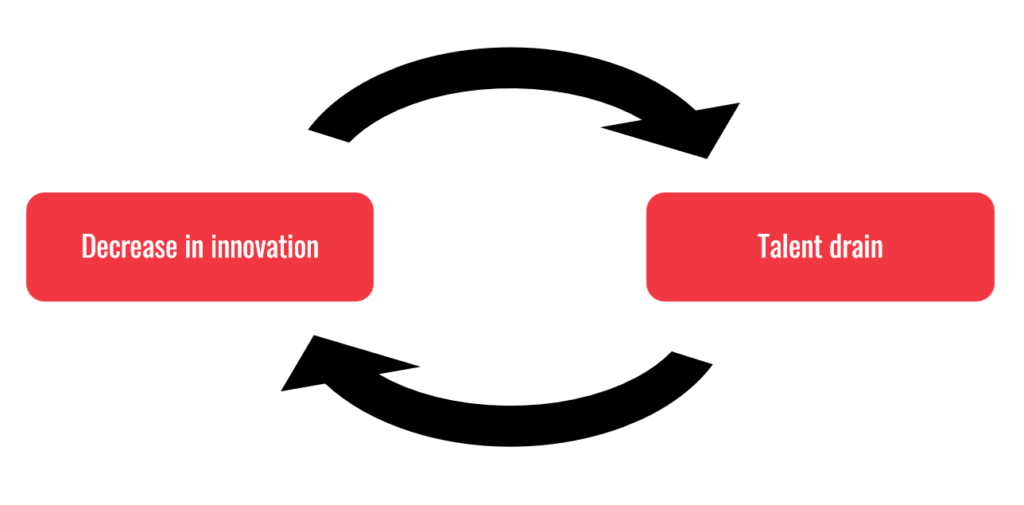The world of Information Technology (IT) is in constant flux. The pace of change is accelerating, fueled by open source projects, container technology, serverless cloud offerings, and distributed computing. These technologies are revolutionizing the IT landscape, and startups are harnessing their power to innovate and disrupt established markets.
However, this rapid evolution presents a paradox. While these advancements have the potential to drive growth and innovation, many enterprises are struggling to keep up, leading to a stagnation in their IT innovation. This issue stems from various factors, including rigid security and control mechanisms, the quest for architectural perfection, and the desire to attract top-tier IT talent.
For this post my goal is to describe the current events. To state the facts and describe how the current trends will (and are already) impacting IT heavy organizations. I’m not posing any solutions in this post, I do have some ideas, and there surely are solutions which I will expand on in future blog posts. This post is only about addressing the problem.
1. Security and Control in an Ever-Changing Landscape
Security and control mechanisms are critical to any enterprise. They are essential for protecting valuable data, ensuring compliance with regulatory standards, and maintaining the integrity of business operations. However, as the IT landscape continues to change at an unprecedented rate, these mechanisms face increasingly significant challenges.
The advent of technologies such as AI assistance for developers, which can double developer productivity, exemplify this dilemma. While these tools offer tremendous potential, many large IT organizations block them due to potential ramifications. This cautious approach, often rooted in IT egocentrism1 and other tribalistic behavior, hampers innovation and puts these organizations at a disadvantage2.
A sense of ownership is a critical aspect of a healthy work culture. It spurs responsibility and drives people to take an active part in their roles. However, this sense of ownership can inadvertently create silos that hinder the free flow of information and ideas. This “silo effect” stifles innovation by confining knowledge within specific groups, limiting its broader application and potential for sparking new insights3.
The Silo Effect
Once upon a time, in the metropolitan concrete jungle of Technoville, there was a mighty enterprise organization known as “MegaCorp”. It was so big, they had to rent two buildings just to house the coffee machines. At the heart of this mammoth organization was Sam, the IT security guy. He was so good at his job, he could detect a phishing email faster than you could say “Nigerian Prince”.
One glorious Monday, a team of bright-eyed developers had an idea. They’d created a software tool so revolutionary, it could save the company the equivalent of a small country’s GDP in work hours. However, there was a small catch – it needed to chat with an external cloud-based server occasionally.
With a mix of excitement and apprehension, they knocked on Sam’s door. Sam, ever the IT sentinel, studied their proposal like an owl scrutinizing a mouse. He saw the potential security risks associated with external connections and his eyes widened – “That’s like opening our front door and inviting the entire internet to a house party!”
Despite the developers explaining the potential benefits and their risk mitigation strategies, Sam remained skeptical. He was not being obstinate, but he was the digital gatekeeper, the watchful protector against all things cyber-evil.
Sam’s steadfast dedication to his role was admirable, but it also was a classic case of “Silo Mentality”. His single-minded focus on security inadvertently erected a wall between him and the rest of the organization, blocking potential avenues for innovation. The shiny new software tool was shelved, and the developers went back to their desks, slightly deflated, their dreams of doubling the company’s revenue in shambles.
And so, in the grand towers of MegaCorp, the ‘Silo Effect’ had struck again, showing how even the most well-intentioned vigilance could sometimes stand in the way of progress and a well-deserved bonus.
2. The Lure of Generic Solutions: The Architect’s Dilemma
In response to the rapid pace of change, many enterprises have increasingly focused on architecture and mature software engineering to maintain control. Architects, often seeing patterns everywhere, have a tendency to drive the development of generic, universal solutions4.
However, this approach has a significant drawback: it frequently results in overly complex solutions that are difficult to maintain or replace later. Agile development practices have emerged in response to this issue, offering a more flexible and responsive way to deliver value5. Yet, the quest for architectural control continues to stifle innovation in many enterprises.
3. The IT Talent Conundrum
Top-tier IT talent is a crucial asset for any organization. However, a decrease in innovation can make an enterprise less attractive to these high-performing individuals. The most vigorous IT experts are often those who thrive on innovation and challenge. If they perceive an organization as resistant to change, they may choose to take their talents elsewhere6.
This talent drain can create a vicious cycle. As enterprises lose their most innovative minds, their ability to adapt and innovate decreases even further, making them less attractive to potential new talent. This cycle can leave companies stuck in a state of stagnation, unable to keep up with the rapidly changing IT landscape.

4. The Paradoxical Result: Stagnation Amidst Acceleration
These factors – rigid security and control mechanisms, a tendency towards overly complex solutions, and an inability to attract top-tier talent – come together to create a paradoxical situation. While the IT world is changing at an accelerating pace, many enterprises find themselves unable to keep up, leading to stagnation in IT innovation.
This stagnation not only puts these companies at a competitive disadvantage but also threatens their very survival in the digital age. Enterprises that cannot adapt quickly enough may find themselves outpaced by more agile competitors and, in the worst cases, could even face the risk of obsolescence.
Stagnation Amidst Acceleration
Let’s take a look at the story of Xerox, a company that was once a household name. Xerox, known for its photocopiers, was a pioneer in many digital communication tools such as the PC, ethernet, and graphical user interface. However, despite these groundbreaking inventions, Xerox failed to capitalize on them.
The company’s rigid control mechanisms and a lack of innovation led to its downfall. Xerox was so focused on its existing business of making copiers that it failed to see the potential of its own digital inventions. It had the opportunity to become a leader in the digital technology industry, but instead, it chose to stick to its traditional business model.
As the digital age advanced, Xerox found itself unable to keep up. Other companies were quick to adapt to the changing times, while Xerox remained stagnant. Despite having the technical knowledge and resources to thrive in the digital age, Xerox’s inability to innovate and adapt led to its failure.
In 2018, Xerox ceased to exist as an independent company after a Japanese imaging and photography company acquired a majority stake. This story serves as a stark example of how rigid security and control mechanisms, coupled with a lack of innovation, can lead to a company’s downfall in the face of rapid technological advancements.
5. Shifting the Paradigm: Towards Greater Adaptability
The solution to this paradox may lie in a shift in how enterprises approach IT. Rather than focusing on rigid control mechanisms and universal solutions, companies need to embrace agility and adaptability. They should focus on creating a culture of continuous learning and improvement, where change is not just accepted but actively sought out.
Technologies such as GitOps, composable applications, and cloud-native architectures can provide the flexibility needed to adapt to rapid changes. Meanwhile, fostering a culture of innovation can help attract and retain top-tier IT talent, breaking the cycle of stagnation and making the company more competitive in the digital age.
In conclusion, what is needed in this world of accelerating innovation and competitiveness is a paradigm shift for large companies to stay relevant. In further posts I will expand on some of my thoughts on how we can address this issue.
References
- “The IT Ego” InfoWorld, 2006
- “Complacency in corporate culture and the role of security in digital transformation” IT World Canada, 2018.
- “Overcoming Data Silos In Your Organization” Forbes, 2020)
- “Software architecture and agile software development: a clash of two cultures?” Philippe Kruchten via IEEE, 2010
- “A decade of agile methodologies: Towards explaining agile software development” Torgeir Dingsøyr via Journal of Systems and Software, 2012
- “Reimagining tech talent” Deloitte Insights, 2022


Leave a Reply